The Three Musketeers. David Crosby, Stephen Stills and Graham Nash. The Marx Brothers. History is filled with trios that are simply great together. And that’s definitely true in the NHL.
Hockey lines have been labeled as far back as the 1920s when Bun Cook, Frank Boucher and Bill Cook formed the Rangers’ A-Line which was the train line that ran right underneath their home rink, Madison Square Garden. The naming of lines had its heyday in the 1950s and 60s but has since waned; one of the many drawbacks of the frequency of player movement.
A great line isn’t always the best three players on a team. It’s often more of a chemistry that’s formed, where each player complements one another. There’s a sixth sense of knowing one another’s position on the ice and anticipating a pass. Skill and talent? They certainly help, too.
There have been amazing duos (i.e. Sidney Crosby and Evgeni Malkin), but this article is about the best trios–the best lines in the history of the NHL. Consistency, longevity and team success all play a role in making the list. Above all, they need to score and drive play. A clever nickname helps, too.
Honorable Mentions
The Nitro Line – Boston Bruins (1967-1975)
Phil Esposito–Wayne Cashman–Ken Hodge
The Nitro line was explosive, leading led the Bruins to two Cups (1970 and 1972). With this trio, the Bruins never missed the playoffs. Two-thirds of the line (Esposito and Hodge) were acquired in what turned out to be an extremely lopsided trade with the Chicago Blackhawks before the 1967 season.
The MVP Line – Tampa Bay Lightning (2006-08)
Vaclav “Vinny” Prospal–Vincent Lecavalier-Martin St. Louis
With Marty, Vinny, Prospal, this line lived up to its name. They came through with goals and more goals. Over the span of two seasons, this trio put up 497 points between them. Lecavalier won the “Rocket” Richard Trophy in 2006-07 with 52 goals.
The Kid Line – Anaheim Ducks (2006-07, 2013)
Dustin Penner-Ryan Getzlaf–Corey Perry
This Kid Line dominated at two different points in the Ducks’ timeline. At 21 years old, Getzlaf and Perry were the top two scorers for the Ducks in the 2007 postseason en route to a Stanley Cup.


Penner left for the Edmonton Oilers as a free agent that summer, but returned in 2013 as a free agent. The trio picked up where it left off, averaging 4.28 goals per 60 minutes at 5-on-5.
The Perfection Line – Boston Bruins (2010s)
Patrice Bergeron–Brad Marchand–David Pastrnak
This line has been one of the best in the NHL over the past few seasons. With a blended mix of defense, peskiness, and sheer skill, they have an uncanny chemistry and consistently drive possession. They drove the Bruins to the Stanley Cup Final last season, but ultimately fell short, losing to the St. Louis Blues.
The (unnamed) Line – Nashville Predators (2016-2020)
Viktor Arvidsson–Ryan Johansen–Filip Forsberg
Chew on this: from 2016-17 to 2019-20, the Predators scored 62.71% of the goals while this group was on the ice at 5-on-5 play. The number popped up to an astonishingly high 68.75% in 2017-18. The Preds made it to the Cup Final (losing to the Pittsburgh Penguins) and two conference finals.
The A Line – New Jersey Devils (1999-2002)
Patrik Elias–Jason Arnott–Petr Sykora
The A-Line had a multi-year run as the Devil’s dominant line and is likely the franchise’s most famous to ever take the ice.

Brimming with chemistry, the trio led the Devils to the Stanley Cup in 2000 and 2001–winning the first and losing the second. Spanning two seasons (1999-2001), they combined for 428 points.
The Cash Line / The Capital Punishment Line / The Pizza Line – Ottawa Senators (2005-08)
Dany Heatley–Jason Spezza–Daniel Alfredsson
This trinity of Ottawa Senators earned many nicknames. The first, The Cash Line, was simply an acronym of the ‘C’ in ‘captain; and the initials of each player… Alfredsson, Spezza and Heatley. They were also known as the Capital Punishment Line for their filling the net and for being located in the capital of Canada. The third name, the Pizza Line, was due to a home promotion that rewarded all attending fans with a free slice of pizza from a local restaurant chain when the team scored five goals or more. The team scored five or more at home 10 times out of 41 regular season games in 2005-06. They did it five more times the following season.
These three players were Ottawa’s top three scorers from 2005-2009. They put up 296 points in 2005-06, 279 points in 2006-07, 263 in 2007-08, and 219 in 2008-09. They lifted the Senators to the 2007 Stanley Cup Final.
In 2008, the trio became the first forward line to be named in its entirety to the All-Star Game since 1981.
The (unnamed) Line – Buffalo Sabres (1992-93)
Dave Andreychuk–Pat LaFontaine–Alex Mogilny
This line doesn’t have a nickname and it lasted less than a season, but it was brilliant during the 1992-93 season. LaFontaine put up an extraordinary 148 points, including 53 goals (yet he was still second to Mario Lemieux-160 points in just 60 games) for the Art Ross Trophy. Mogilny had a career-best 76 goals, tying him with Teemu Selanne for the league lead. And Andreychuk crashed the crease with 62 points in 51 games before being dealt to the rival Maple Leafs.
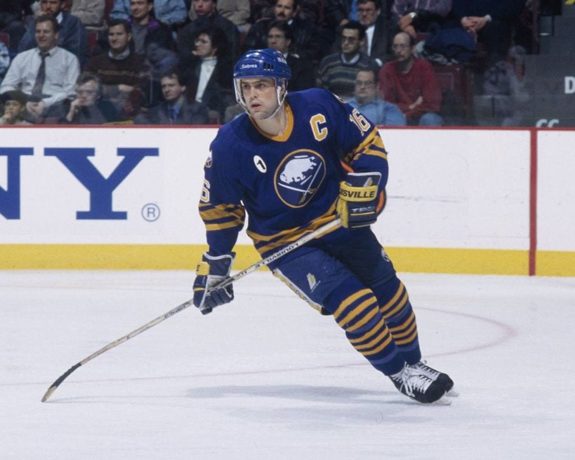
Had Andreychuck stayed in Buffalo, it would likely have been the first time in league history that each member of a line reached the 50-goal mark. He finished with 54 goals that season.
The Kid Line- Toronto Maple Leafs (1929-1936)
Harvey “Busher” Jackson-Joe Primeau-Charlie Conacher
Maple Leafs head coach, Conn Smythe, arranged the Kid Line when his team moved into the historic Maple Leaf Gardens in 1931. Conacher, 23, was joined by the two 18-year-olds and the line was an instant hit, delivering the franchise’s third Stanley Cup. The Leafs made it to four Stanley Cup Finals in the next six seasons but failed to win it again. Individually, Conacher led the league in scoring twice and Jackson led the league in scoring once while they were members of the Kid Line. All three players are members of the Hockey Hall of Fame.
The Pony Line – Chicago Black Hawks (1945-48)
Max Bentley-Doug Bentley-Bill Mosienko
Two brothers and Mosienko were all small in stature. None of them weighed more than 160 pounds, but they could all skate like the wind. Max was a playmaker, winning two Art Ross trophies and a Hart trophy. Doug, the older brother played a more well-rounded game. Mosienko, who still holds the record for scoring three goals in the span of 21 seconds, had a knack for finding and creating open ice.
Though they only spent two full seasons together, they were the league’s highest-scoring line in both years.
The unnamed Sedins Line – Vancouver Canucks (2008-12)
Alex Burrows–Henrik Sedin–Daniel Sedin
Despite playing together for most of seven seasons and being the best line in Canucks history, this line never earned a true nickname. The puck-cycling Swedish Sedin Twins had a knack for knowing where the other was without looking, while Burrows added physicality and power.
In their time together, both Twins have won an Art Ross Trophy and an MVP award (Hart for Henrik, Lindsay for Daniel). Burrows has been no slouch either, scoring a career-high 35 goals for the club in 2009-10, and scoring big goals in the team’s march to the 2011 Stanley Cup Final.

At his Ring of Honour ceremony in 2019, Burrows had some kind words for his linemates. “Special thank you to Hank and Danny [Henrik and Daniel Sedin], you guys are the best,” said Burrows. “Obviously I want to thank you guys for all those backdoor tap-ins you guys gave me, but more importantly you guys always believed in myself and you guys have no idea what it meant to me, so thank you very much. You guys are living legends, future Hall of Famers, and obviously the best role models I could ever ask for, so thank you very much.”
During their four seasons together, the franchise had its most successful era in their history. They won four division titles, two Presidents’ Trophies and made it to Game 7 of the 2011 Stanley Cup Final.
The LCB Line – Philadelphia Flyers (1974-1981)
Reggie Leach–Bobby Clarke-Bill Barber
The LCB line vaulted the Flyers to a Stanley Cup in their first and second season together and went to the Finals several more times before their separation. In 1975-76, the line notched 141 goals (Leach 61, Clarke 30, Barber 50), setting an NHL record for goals by a single line.
The (unnamed) Line – Washington Capitals (2007-09)
Alex Ovechkin–Nicklas Backstrom-Alex Semin
Ovechkin, one of the most prolific goal scorers the game has ever seen, combined with a fellow a Russian and a Swede. Ovi’s 65-goal season in 2007-08 still stands as his career best. This line combined for 571 points in their two seasons together. Not too shabby.
The Party Line – Chicago Blackhawks (1980s)
Steve Larmer-Denis Savard–Al Secord
Savard led the Blackhawks in scoring seven straight seasons including five 100-point campaigns. The Party Line set a team-mark of 197 points in 1982-83 with Larmer winning the Calder Trophy hardware as the league’s top rookie.
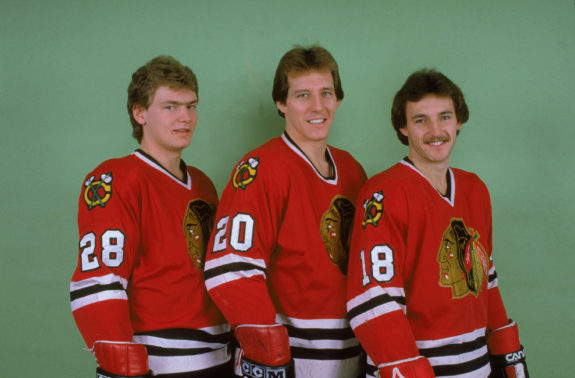
The dangerous line never won a Cup in Chicago, but Savard and Larmer hoisted the trophy after leaving the Windy City. Savard won with the Tampa Bay Lightning (1993) and Larmer with the New York Rangers (1994).
The Finnish Sandwich – Edmonton Oilers (1983-1988)
Jari Kurri-Wayne Gretzky-Esa Tikkanen
Wayne Gretzky could make any line productive. But when Kurri and Tikkanen, two Fins, flanked him, the entire line was unstoppable. When put together in 1983, the Oilers dominated the league and broke the NHL record for most goals by one team in a season (446). Gretzky tallied 205 points and led the team to a staggering 57 wins in 80 games.
The explosive Oilers teams of the 1980s are the only ones to break the 400-goal mark, doing it five straight seasons between 1981-82 and 1985-86. They won four Stanley Cups in the span of five years, one of the best runs by any team in league history and it was largely due to this trio.
The GAG Line – New York Rangers (1964-1974)
Vic Hadfield–Jean Ratelle–Rod Gilbert
The GAG Line, short for ‘goal-a-game,’ scored… a lot. Though they never won a Stanley Cup, they transformed the Rangers into contenders. Their demise was Bobby Orr and the Boston Bruins who defeated them several years in the playoffs including in 1972. That season, the trio managed 312 points– the highest scoring line in team history. They finished 3-4-5 in scoring, behind the Bruins’ Phil Esposito (133) and Bobby Orr (117).
Gilbert finished among the top 10 scorers in the league four times (he also made the top 10 the year after the line dissolved) during his tenure on the GAG line and Ratelle scored at least 32 goals five times.
The Legion of Doom – Philadelphia Flyers (1994-97)
John Leclair–Eric Lindros–Mikael Renberg
While the Broad Street Bullies were an intimidating team in the 1970s, this trio was just as scary to play against two decades later. They were named after a group of DC comic villains headed by Lex Luthor. Leclair (6-foot-3, 226), Lindros (6-foot-4, 240) and Renberg (6-foot-2, 235) were an imposing mix of playmakers and punishers.

The line was formed in 1994 and led the Flyers to their first division crown in eight years. In a span of three seasons together, the Flyers were legit contenders. They made it to the Eastern Conference Final twice (1994-95, 1996-97) and the Stanley Cup Final once (1996-97).
The Dynasty Line – Montreal Canadiens (1970s)
Steve Shutt–Peter Mahovlich/Jacques Lemaire–Guy Lafleur
Though this line was originally dubbed the Dynasty Line, Shutt called it the Donut Line because it had no firm center.
Peter Maholich occasionally took Lemaire’s place at center. The speedy Lafleur, hard-nosed Lemaire and opportunistic Shutt helped the Canadiens win five Stanley Cups, including four straight, starting in 1995.
The Grind Line – Detroit Red Wings (1996-98)
Darren McCarty–Kris Draper–Joey Kocur/Kirk Maltby
The Grind Line was tough, gritty and not afraid of anything. They were way more than a checking line, routinely chipping in offense as well as shutting down top scorers from the opposition.
Related: Red Wings’ All-Time Greatest Lines
More than anything, though, they brought energy on every shift, harassing opponents. Not surprisingly, the players were part of the last four Stanley Cups won by the team in the Motor City.
The Scooter Line – Chicago Blackhawks (1960s)
Doug Mohns-Stan Mikita-Ken Wharram
While Bobby Hull and Stan Mikita put up astronomical numbers with the Blackhawks, they weren’t even linemates. Mikita centered the Scooter Line, with Wharram and a revolving winger (Ted Lindsay, who was replaced by Ab McDonald and later Mohns).
Wharram played parts of 14 NHL seasons, all with the Hawks, and scored at least 20 goals in seven consecutive seasons from 1962-69. He was a member of two All-Star teams and was known for his speed as a skater.
The dominant scoring line was featured in their own “History Will Be Made” commercial that aired during the 2010 NHL Playoffs.
The Century Line – Pittsburgh Penguins (1972-1976)
Lowell MacDonald-Syl Apps, Jr.-Jean Pronovost
This combination was one of the most explosive units ever, averaging 100 goals and 233 points per season. While they had tremendous success, the Penguins only qualified for the playoffs twice and never made it past the second round.
They were initially called “The MAP Line”–a play on the first letters of their last names. Pronovost was the kid brother of Hall-of-Fame defenseman Marcel Pronovost. He had great speed and sure hands. MacDonald was riddled with knee injuries and plucked from the Los Angeles Kings in the 1970 Intra-League (waiver) Draft. Apps, the son of his legendary father, was a late bloomer.
The line had a chemistry where they just knew where the other guys were going to be. “Lowell and I couldn’t shoot the puck any more than 15 feet; that’s why we did a lot of passing,” Apps told Joe Starkey in Tales from the Pittsburgh Penguins. “Plus, Lowell couldn’t see that far. I think he had a worse shot than I did, but, boy, could he pick his spot. We were a little bit of a throwback in that we didn’t dump the puck and we used a lot of drop passes.”
A team publicist dubbed them The Century Line after scoring over 100 goals during the 1973-74 season. They lived up to the name and then some. For the next two years, the trio ranked among the most lethal combinations in the league. After tallying an impressive 94 goals in 1974-75—including a team-best 43 by Pronovost—the unit exploded for 114 goals in 1975-76. Pronovost (52 goals) and Apps (99 points) finished among the league’s top ten scorers, while MacDonald potted 30 goals.
The line scored 100+ goals and 200+ points for 4 straight seasons. As a four-time All-Star, Pronovost remains fifth on the club’s all-time list in goals (316) behind some pretty select company—Mario Lemieux, Sidney Crosby, Jaromir Jagr and Evgeni Malkin.
The Top 10 Lines in NHL History
It’s nearly impossible to rank lines from different eras, so rather than slighting one over the other, we present our Top 10 Lines.
The Kraut Line – Boston Bruins (1936-42, 1945-47)
Woody Dumart–Milt Schmidt–Bobby Bauer
This trio was originally called The Sauerkraut Line, then shortened to the Kraut Line. These three players were of German descent and all hailed from Berlin, Ontario, which changed its name to Kitchener after World War 1. The forwards finished 1-2-3 in scoring in 1940 and won two Stanley Cups (1939 and 1941). For obvious reasons, as World War 2 came on, they changed their name to the Kitchener Kids.
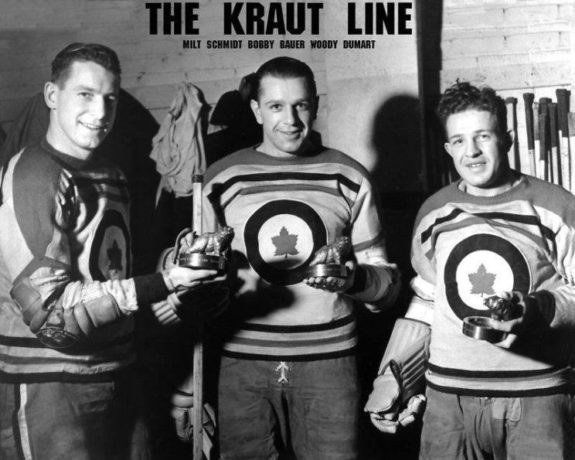
All three members of the line joined the Royal Canadian Air Force for World War II, but returned to the Bruins afterwards. In their final game, before flying to serve for the Royal Canadian Air Force, the trio notched 22 points in a lopsided 8-1 victory over Montreal.
In an unbelievable act of kindness and genuine admiration, that night, Canadiens players actually hoisted the three Bruins onto their shoulders and skated them around a rink in joyful celebration.
The MPH Line – Chicago Blackhawks (1968-75)
Pit Martin-Jim Pappin-Dennis Hull
The Chicago front office initially wanted this line to feature the older Hull brother, Bobby, but when he held out, they gave the spot to his little brother, Dennis.
In their seven seasons together, the MPH Line piled up over 1,300 points – setting a team record for points in a season (272 in 1972-73) – and helped fill the offensive void left by Bobby Hull’s departure to the WHA in 1972.
This well respected trio was even voted as the starters in the 1974 All-Star Game together, and were introduced at that All-Star game (and skated onto the ice) together. They were as incredible offensively as they were defensively.
“It was really special for us,” Hull says. “We were recognized by the rest of the team as one – the MPH Line from the Blackhawks. As we were being introduced, Jimmy told the TV guys that we didn’t want to be introduced individually. I think that’s the only time that’s ever happened.”
“We seemed to be the perfect line because each of us knew what our job was,” explained Hull. “Everybody knew what they were supposed to do. Pit was fast and good with the puck; Jimmy was a great playmaker; and I could shoot. We each did well and we wanted each other to succeed as well.”
The Sky Line – Pittsburgh Penguins (1990-94)
Mario Lemieux–Jaromir Jagr–Kevin Stevens
Lemieux and Jagr were arguably the most electric duo of their era. Stevens gave them an added edge, striking fear into goalies every time they took the ice. In their first two seasons, they led the Pens to back-to-back Stanley Cups. The line didn’t stay together too long, as Lemieux battled off the ice with Hodgkin’s Lymphoma for a year and Stevens was traded away the following season. Short-lived, but definitely dominant.
The Triple Crown Line – Los Angeles Kings (1979-84)
Charlie Simmer-Marcel Dionne– Dave Taylor
Named after the team logo (the King’s Crown), and tied with the association of horse racing’s ultimate accomplishment, this regal line was a force on the ice.
It was formed in January 13, 1979 and instantly became one of the league’s most prolific units. That night Dionne scored four goals and the team easily beat the Red Wings, 7-3. They’re the first trio to each score 100 points in the same NHL season. During the 1979-80 season, the line produced 146 goals and 328 points.
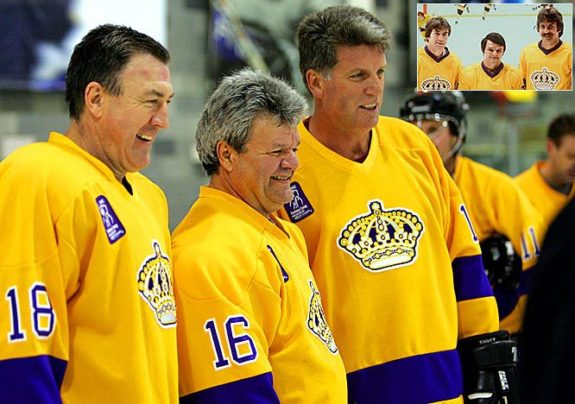
The threesome averaged a whopping 219 points per season in their seven seasons together.
The Punch Line – Montreal Canadiens (1942-48)
Toe Blake–Elmer Lach–Rocket Richard
These guys, assembled by Habs head coach Dick Irvin, were known for their offensive punch. And maybe a little more if you got on the Rocket’s wrong side.
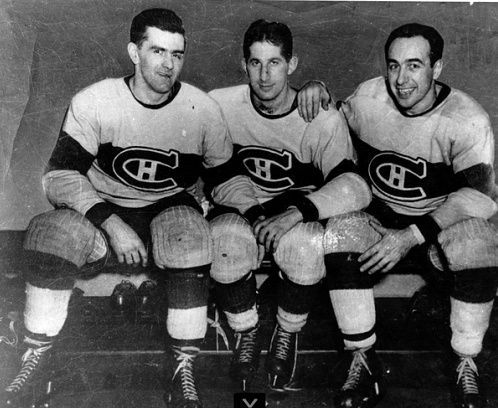
In 1943-44, the threesome piled up 220 points and set an NHL record that didn’t fall until the 1960s. The famed trio finished 1-2-3 in scoring the following season.
In all, the trio helped the Canadiens win the Stanley Cup twice (1944 and 1946) before a broken leg forced Blake to retire in 1948. Lach set an NHL single-season record in 1944-45 with 80 points in a 50-game schedule. Many of his 54 assists came on goals by Richard, who sets an NHL record with 50 goals in 50 games. They’re one of the most famous lines in Montreal Canadiens history.
The Stastny Brothers – Quebec Nordiques (1981-85)
Peter Stastny-Anton Stastny-Marian Stastny
When three brothers form a line, it’s pretty easy to name it. It’s another to stop it. The forwards defected from Czechoslovakia and became one of the league’s most exciting and successful scoring lines. Their success helped fast-track the acceptance of European players in the NHL.
In 1980-81, the season before Marian arrived, Peter set NHL rookie records for assists (70) and points (109) while winning the Calder Trophy as Rookie of the Year (1980). Anton was no slouch, adding an impressive 39 goals and 85 points. In one game against Washington, the two brothers scored eight points each, setting a new NHL road record.
Once Marián arrived the trio took the NHL by storm, amassing 300 points in 1981-82. He had a red-hot rookie season, putting up 89 points. A devastating shoulder injury ended his season early the following year.
There was only one player who score more points than Peter Stastny in the 1980s: Wayne Gretzky. He consistently led the team in scoring. Anton put up 636 points in 650 games-the third highest in Nordiques history. While the Stastnys put up impressive numbers, they struggled in the playoffs. Twice they made it to the Conference final, losing to the New York Islanders in 1982 and the Philadelphia Flyers in 1985.
Surprisingly, the Stastnys weren’t the first line of brothers in the NHL. Max, Doug and Reg Bentley played for the Chicago Blackhawks (1940s) and Barclay, Bob and Bill Plager played for the St. Louis Blues (1970s).
Long Island Lightning Company / The Trio Grande – New York Islanders (1977-87)
Mike Bossy–Bryan Trottier–Clark Gillies
Named after the local utility and known for constantly lighting up the goal light behind the net, this line won the Cup four straight years (1979-83). They will probably be the last to ever do so. Bossy was a pure sniper, Trottier was a playmaker and Gillies was a rugged, physical player who worked the corners.
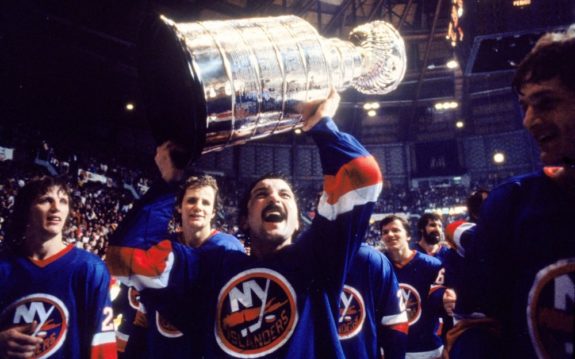
In 1977-78, Bossy set a record with 53 goals poured in 69 in his second season. Trottier also had a banner year in their second season together; he led the league in scoring and was named league MVP. Gillies established himself as a leader and a significant scoring threat with four consecutive years scoring 30 or more goals (1975-1979). He scored 319 goals and 378 assists for 697 points – superior totals for an “enforcer” – while amassing 1,023 PIMs in 958 regular season games.
Bossy, Gillies and Trottier are all members of the Hockey Hall of Fame.
The Russian Five – Detroit Red Wings (1990s)
Slava Kozlov–Igor Larionov–Sergei Fedorov–Vyacheslav Fetisov–Vladimir Konstantinov
Why stop at three players? This Russian quintet was a powerhouse that dominated the NHL with precision passing, speed, slick playmaking and goals that would leave your jaw on the ground. They were aggressive but played a full 200-foot game.
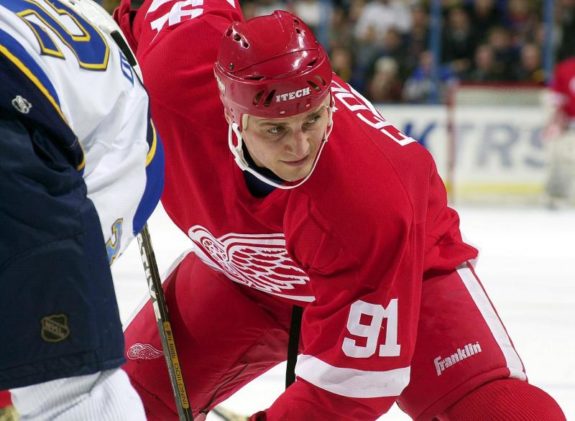
Assembled by head coach Scotty Bowman, the unit helped led to the Wings winning it all in 1997. Though tragedy struck Konstantinov with a devastating career-ending injury, the other four Russians helped the team repeat as champions the following season.
The French Connection – Buffalo Sabres (1972-79)
Rick Martin–Gilbert Perreault-Rene Robert
Named after the 1971 Academy Award-winning film, these three outstanding French Canadien players dazzled the upstart Sabres in the early years of the franchise. They were a mix of speed, finesse and sheer talent.
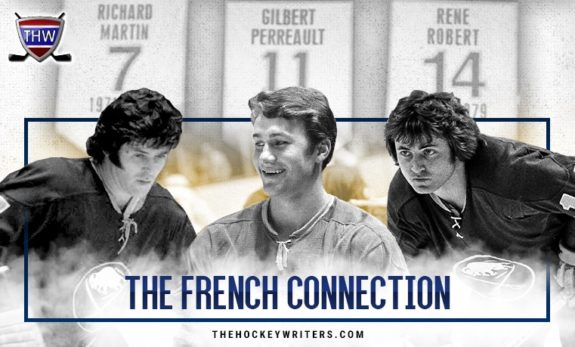
In their first full season together, they finished one-two-three in team scoring and took the Sabres to the franchise’s first trip to the playoffs. Two years later, in 1974-75, they carried the Sabres to a truly magical Stanley Cup run, which fell two wins short of the prize.
The Production Line – Detroit Red Wings (1947-52)
Ted Lindsay–Sid Abel-Gordie Howe
These guys could produce points with the same consistency as the then-booming Detroit automotive production lines.
Red Wings head coach Tommy Ivan took over the team in 1947 and put youngsters Howe and Lindsay on a line with future Hall of Famer Sid Abel. The trio, who spent extra time after practice working together, had tremendous chemistry showed on ice and immediately paid dividends.
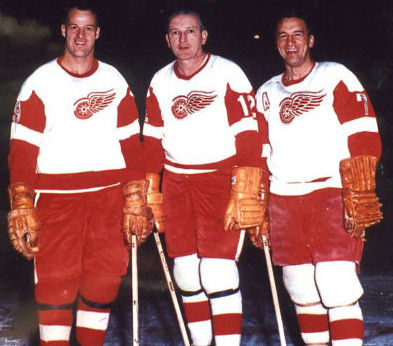
The Production Line led the Red Wings to two Stanley Cups (1950 and 1952), while winning three Art Ross trophies among them. In the 1949-50 season, they swept the scoring race, finishing one-two-three in scoring. Howe and Lindsay finished one-two four more times.
Even more incredible, is that over 11 seasons, all three members finished in the NHL’s top 20 in scoring. The scoring trio won four Cups, have all been inducted into the Hall of Fame and had their numbers retired.


I loved the West Coast Express, but they could only keep it together for a couple of years. All three of those players, bertuzzi, naslund and morrison have been plagued by inconsistency and confidence issues thoughout their careers. Had Bert not screwed up and Naslund not gotten tired, who knows? A great line, but they didnt make history.
Now lets see the top ten lines in 2010…. you can start with the Tom And Lerri line in Montreal.
What about the West Coast Express?
Very nice list sir. Only omission I really see here is the MPH Line for the Chicago Blackhawks. During their seven years together, Pit Martin, Jim Pappin, and Dennis Hull combined for over 1300 points. If I remember correctly, they had a year during the early 70’s when they had nearly 300 points as a group.
The lines you have are fantastic, but that MPH Line was really something special.
First, I really like this list. Cool stuff and some hockey history for those, like myself, who were not around to see some of these classic lines. Since I’m from Ottawa and gained significantly from this trio, I’d like to mention the Pizza Line: Daniel Alfredsson, Jason Spezza, and Dany Heatley. These guys dominated in 2005-2006, with Alfredsson 103pts in 77 games, Spezza 90pts in 68 games, and Heatley 103pts in 82 games. Together these guys got me and many happy fans lots of free pizza for scoring 5 or more goals in a game. Cheers to them!
Bruce: Another line comes to mind: Jean Beliveau – Boom Boom Geoffrion – Bert Olmstead, playing at the same time as Maurice Richard – Henri Richard – Dickie Moore. That was some team!
HI. nice article. I think Billy Harris was traded (along with Dave Lewis for Butch Goring) before the Isles ever won a cup. The line that went on to four straight cups and a 5th straight final was Trottier, Bossy and Gillies. If Harris was indeed part of the “Long Island Lighting Co.”line, it was only a short while and not for any cups.
And that line was commonly known as the Tri Grande by the 1979-80 season …
Trio Grande …
Trust me. I watched it.
What of the NY Rangers’ Goal-a-Game (“GAG”) line of Rod Gilbert (RW), Jean Ratelle (C), and Vic Hadfield (LW)? Two HOF guys, after all. Recall that Trottier and Bossy played with several left wings, including Tonelli and Bourne, and the LILCO name faded away (actually, they were the “Trio Grande,” because the LILCO line was originally Trottier, Gillies, and Bill Harris), but a lot of hockey writers get that confused.
http://en.wikipedia.org/wiki/List_of_ice_hockey_line_nicknames
Thanks Brooks – I did consider the GAG line…just ran out of numbers..
Bruce: two lines that deserve honorable mention (at least) 1) Patrik Elias – Jason Arnott – Peter Sykora , considered best in league at one time 2) Guy Lafleur – Steve Shutt – Jacques Lemaire, who were awesome to watch Yours is a great list and filled with great memories.
Hi Kevin – thanks for that.
I chose not to include the Lemaire line simply because while they played the were never refereed to with a moniker. I’ve heard them called the Dynasty line but living here in Montreal I can tell yo that nobody I knew ever called them that….
I considered the A-Line as well as the EGG line…hard to stop at 10.